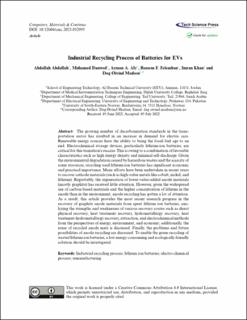| dc.contributor.author | Abdallah, Abdallah | |
| dc.contributor.author | Dauwed, Muhamed | |
| dc.contributor.author | Aly, Ayman A. | |
| dc.contributor.author | Felemban, Bassem F. | |
| dc.contributor.author | Khan, Imran | |
| dc.contributor.author | Madsen, Dag Øivind | |
| dc.date.accessioned | 2023-05-31T07:56:46Z | |
| dc.date.available | 2023-05-31T07:56:46Z | |
| dc.date.created | 2023-03-08T10:07:22Z | |
| dc.date.issued | 2023 | |
| dc.identifier.citation | Abdallah, A., Dauwed, M., Aly, A.-A., Felemban, B.-F., Khan, I. & Madsen, D.-Ø. (2023). Industrial Recycling Process of Batteries for EVs. Computers, Materials \& Continua, 74(2), 4571-4586. | en_US |
| dc.identifier.issn | 1546-2218 | |
| dc.identifier.uri | https://hdl.handle.net/11250/3069410 | |
| dc.description.abstract | The growing number of decarbonization standards in the transportation sector has resulted in an increase in demand for electric cars. Renewable energy sources have the ability to bring the fossil fuel age to an end. Electrochemical storage devices, particularly lithium-ion batteries, are critical for this transition’s success. This is owing to a combination of favorable characteristics such as high energy density and minimal self-discharge. Given the environmental degradation caused by hazardous wastes and the scarcity of some resources, recycling used lithium-ion batteries has significant economic and practical importance. Many efforts have been undertaken in recent years to recover cathode materials (such as high-value metals like cobalt, nickel, and lithium). Regrettably, the regeneration of lower-value-added anode materials (mostly graphite) has received little attention. However, given the widespread use of carbon-based materials and the higher concentration of lithium in the anode than in the environment, anode recycling has gotten a lot of attention. As a result, this article provides the most recent research progress in the recovery of graphite anode materials from spent lithium ion batteries, analyzing the strengths and weaknesses of various recovery routes such as direct physical recovery, heat treatment recovery, hydrometallurgy recovery, heat treatment-hydrometallurgy recovery, extraction, and electrochemical methods from the perspectives of energy, environment, and economy; additionally, the reuse of recycled anode mats is discussed. Finally, the problems and future possibilities of anode recycling are discussed. To enable the green recycling of wasted lithium ion batteries, a low energy-consuming and ecologically friendly solution should be investigated. | en_US |
| dc.language.iso | eng | en_US |
| dc.rights | Navngivelse 4.0 Internasjonal | * |
| dc.rights.uri | http://creativecommons.org/licenses/by/4.0/deed.no | * |
| dc.title | Industrial Recycling Process of Batteries for EVs | en_US |
| dc.type | Peer reviewed | en_US |
| dc.type | Journal article | en_US |
| dc.description.version | publishedVersion | en_US |
| dc.source.pagenumber | 4571-4596 | en_US |
| dc.source.volume | 74 | en_US |
| dc.source.journal | Computers, Materials and Continua (CMC) | en_US |
| dc.source.issue | 2 | en_US |
| dc.identifier.doi | https://doi.org/10.32604/cmc.2023.032995 | |
| dc.identifier.cristin | 2132219 | |
| cristin.ispublished | true | |
| cristin.fulltext | original | |
| cristin.fulltext | original | |
| cristin.qualitycode | 1 | |

